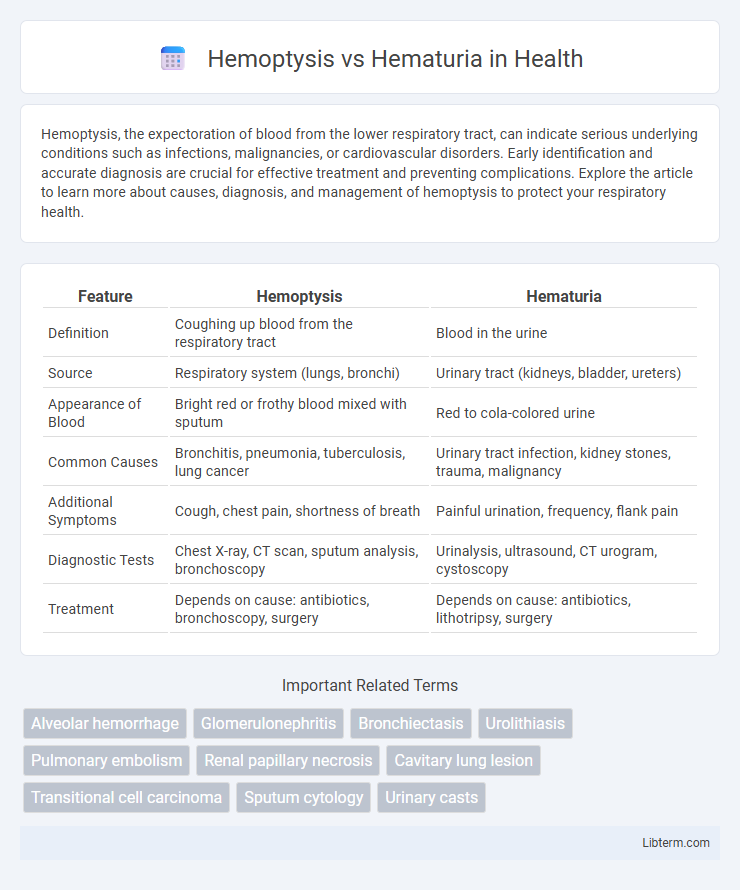Hemoptysis, the expectoration of blood from the lower respiratory tract, can indicate serious underlying conditions such as infections, malignancies, or cardiovascular disorders. Early identification and accurate diagnosis are crucial for effective treatment and preventing complications. Explore the article to learn more about causes, diagnosis, and management of hemoptysis to protect your respiratory health.
Table of Comparison
| Feature | Hemoptysis | Hematuria |
|---|---|---|
| Definition | Coughing up blood from the respiratory tract | Blood in the urine |
| Source | Respiratory system (lungs, bronchi) | Urinary tract (kidneys, bladder, ureters) |
| Appearance of Blood | Bright red or frothy blood mixed with sputum | Red to cola-colored urine |
| Common Causes | Bronchitis, pneumonia, tuberculosis, lung cancer | Urinary tract infection, kidney stones, trauma, malignancy |
| Additional Symptoms | Cough, chest pain, shortness of breath | Painful urination, frequency, flank pain |
| Diagnostic Tests | Chest X-ray, CT scan, sputum analysis, bronchoscopy | Urinalysis, ultrasound, CT urogram, cystoscopy |
| Treatment | Depends on cause: antibiotics, bronchoscopy, surgery | Depends on cause: antibiotics, lithotripsy, surgery |
Introduction to Hemoptysis and Hematuria
Hemoptysis refers to the expectoration of blood originating from the lower respiratory tract, typically indicating airway, lung, or pulmonary vascular pathology. Hematuria denotes the presence of blood in the urine, suggesting possible disorders in the kidneys, urinary tract, or bladder. Both conditions serve as critical diagnostic indicators requiring differentiation based on symptom origin and underlying etiology to guide appropriate clinical interventions.
Definitions and Key Differences
Hemoptysis refers to coughing up blood originating from the respiratory tract, often indicating lung or airway conditions, whereas hematuria is the presence of blood in urine, signaling potential issues in the urinary tract or kidneys. Key differences include their sources--hemoptysis involves bleeding from the lungs or bronchial tubes, while hematuria arises from the kidneys, ureters, bladder, or urethra. Clinically, hemoptysis may be associated with conditions such as bronchitis, pneumonia, or lung cancer, whereas hematuria can indicate urinary tract infections, kidney stones, or malignancies.
Causes of Hemoptysis
Hemoptysis, the expectoration of blood from the lower respiratory tract, commonly results from causes such as bronchitis, bronchiectasis, pulmonary tuberculosis, lung cancer, and pulmonary embolism. In contrast, hematuria involves blood in the urine primarily due to urinary tract infections, kidney stones, glomerulonephritis, or malignancies of the urinary tract. Accurate differentiation between hemoptysis and hematuria is essential for diagnosis and treatment because their underlying etiologies and clinical implications significantly differ.
Causes of Hematuria
Hematuria, the presence of blood in urine, often results from urinary tract infections, kidney stones, or malignancies such as bladder or kidney cancer. Other causes include trauma to the urinary tract, glomerulonephritis, and benign prostatic hyperplasia. Unlike hemoptysis, which involves coughing up blood from the respiratory tract, hematuria specifically indicates bleeding within the urinary system.
Clinical Presentation and Symptoms
Hemoptysis presents as coughing up blood originating from the respiratory tract, often accompanied by symptoms such as chest pain, shortness of breath, and fever, indicating underlying pulmonary conditions like bronchitis, tuberculosis, or lung cancer. Hematuria involves the presence of blood in the urine, presenting as visible red or cola-colored urine, sometimes accompanied by dysuria, flank pain, or urinary frequency, often linked to urinary tract infections, kidney stones, or malignancies. Distinguishing these symptoms through clinical evaluation and diagnostic tests is essential for accurate diagnosis and treatment.
Diagnostic Approaches
Hemoptysis diagnosis involves chest X-rays, CT scans, and bronchoscopy to identify the source of bleeding within the respiratory tract. Hematuria is evaluated through urinalysis, urine culture, and imaging studies such as ultrasound or CT urography to detect urinary tract abnormalities. Both conditions require differentiation through clinical history and laboratory tests to determine the origin of bleeding accurately.
Risk Factors and Epidemiology
Hemoptysis, characterized by coughing up blood, commonly occurs in patients with chronic lung diseases such as tuberculosis, bronchiectasis, and lung cancer, with risk factors including smoking, chronic infections, and pulmonary embolism. Hematuria, the presence of blood in urine, is frequently associated with urinary tract infections, kidney stones, and malignancies like bladder cancer, with risk factors comprising smoking, advanced age, and occupational exposure to certain chemicals. Epidemiologically, hemoptysis is more prevalent in regions with high pulmonary tuberculosis incidence, whereas hematuria shows higher rates in populations with increased exposure to nephrotoxic agents and urologic cancers.
Treatment Options for Hemoptysis
Treatment options for hemoptysis primarily depend on the underlying cause and severity, with initial approaches including airway stabilization and supportive care such as oxygen therapy and blood transfusions if needed. Interventions may involve bronchoscopy for localized bleeding control, endovascular embolization, or surgical resection in cases of significant or recurrent hemorrhage. Medications such as antibiotics, antifungals, or anticoagulant reversal agents are administered based on infectious or coagulopathic etiologies contributing to hemoptysis.
Treatment Strategies for Hematuria
Treatment strategies for hematuria depend on the underlying cause, which can range from urinary tract infections and kidney stones to malignancies. Diagnostic evaluation, including urine analysis, imaging, and cystoscopy, guides targeted therapy such as antibiotics for infections, lithotripsy or surgery for stones, and oncological interventions for tumors. Monitoring and managing comorbidities are essential to prevent recurrent hematuria and potential renal complications.
Prognosis and Prevention Strategies
Hemoptysis, the expectoration of blood from the respiratory tract, often indicates underlying pulmonary conditions such as tuberculosis, bronchiectasis, or lung cancer, and prognosis varies widely depending on the etiology and promptness of treatment. Hematuria, the presence of blood in urine, can signal urinary tract infections, kidney stones, or malignancies, with prognosis largely dependent on timely diagnosis and management of the source of bleeding. Preventive strategies for hemoptysis emphasize controlling infections, avoiding smoking, and managing chronic respiratory diseases, while hematuria prevention focuses on maintaining urinary tract health through hydration, infection control, and regular monitoring for renal or bladder pathology.
Hemoptysis Infographic

 libterm.com
libterm.com